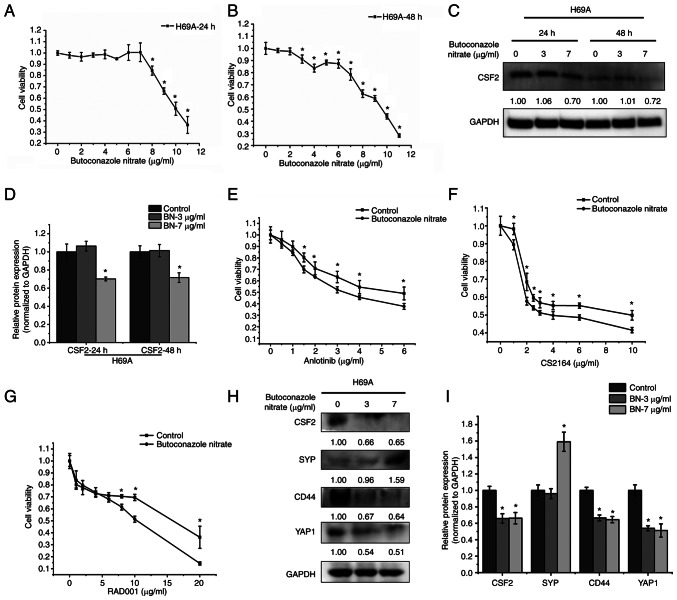Figure 7.
The effect of CSF2 inhibitors on drug sensitivity and the conversion of the non-NE phenotype to the NE phenotype. H69A cells were treated with different concentrations of butoconazole nitrate (0, 1, 2, 3, 4, 5, 6, 7, 8, 9, 10 and 11 µg/ml) and cell viability was detected with Alamar Blue after treatment for (A) 24 h and (B) 48 h. (C) H69A cells treated with 3 and 7 µg/ml butoconazole nitrate. The cells were collected after treatment for 24 and 48 h. The expression of CSF2 and GAPDH were analyzed by using western blotting. (D) Quantitative analysis of (C), mock-treated H69A cells were used as the control (100%). Data are presented as the mean ± standard deviation of three independent experiments. (E) H69A cells were treated with butoconazole nitrate (7 µg/ml) combined with anlotinib (0, 0.5, 1, 1.5, 2, 3, 4 and 6 µg/ml), (F) CS2164 (0, 1, 2, 2.5, 3, 4, 6 and 10 µg/ml) and (G) RAD001 (0, 1, 2, 4, 6, 8, 10 and 20 µg/ml) for 24 h. Cell viability was tested by using Alamar Blue. (H) H69A cells were treated with butoconazole nitrate (3 and 7 µg/ml) for 24 h. Western blotting was used to detect the expression of CSF2, SYP, CD44, YAP1 and GAPDH. (I) Quantitative analysis of (H), mock-treated H69A cells were used as the control (100%). Data are presented as the mean ± standard deviation of three independent experiments. *P<0.05. CSF2, colony-stimulating factor 2; NE, neuroendocrine; CSF2, colony-stimulating factor 2; SYP, synaptophysin; YAP1, YES-associated protein 1.

